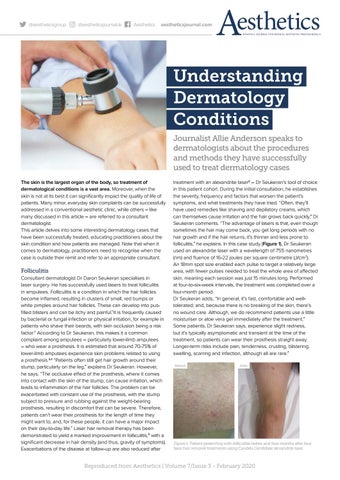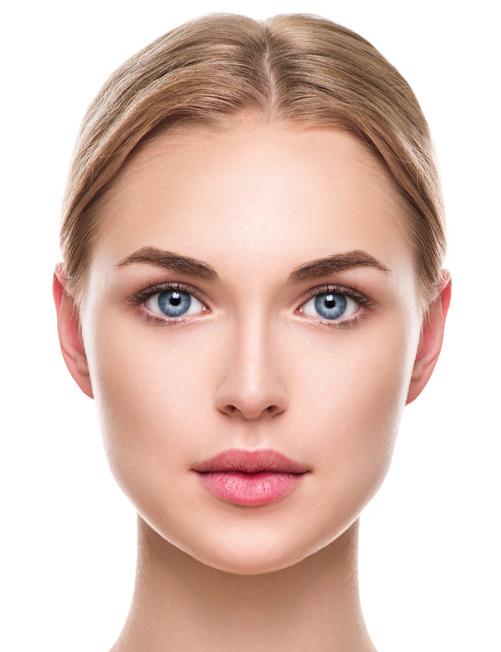@aestheticsgroup
@aestheticsjournaluk
Aesthetics
aestheticsjournal.com
Understanding Dermatology Conditions Journalist Allie Anderson speaks to dermatologists about the procedures and methods they have successfully used to treat dermatology cases The skin is the largest organ of the body, so treatment of dermatological conditions is a vast area. Moreover, when the skin is not at its best it can significantly impact the quality of life of patients. Many minor, everyday skin complaints can be successfully addressed in a conventional aesthetic clinic, while others – like many discussed in this article – are referred to a consultant dermatologist. This article delves into some interesting dermatology cases that have been successfully treated, educating practitioners about the skin condition and how patients are managed. Note that when it comes to dermatology, practitioners need to recognise when the case is outside their remit and refer to an appropriate consultant.
Folliculitis Consultant dermatologist Dr Daron Seukeran specialises in laser surgery. He has successfully used lasers to treat folliculitis in amputees. Folliculitis is a condition in which the hair follicles become inflamed, resulting in clusters of small, red bumps or white pimples around hair follicles. These can develop into pusfilled blisters and can be itchy and painful.1 It is frequently caused by bacterial or fungal infection or physical irritation, for example in patients who shave their beards, with skin occlusion being a risk factor.2 According to Dr Seukeran, this makes it a common complaint among amputees – particularly lower-limb amputees – who wear a prosthesis. It is estimated that around 70-75% of lower-limb amputees experience skin problems related to using a prosthesis.3,4 “Patients often still get hair growth around their stump, particularly on the leg,” explains Dr Seukeran. However, he says, “The occlusive effect of the prosthesis, where it comes into contact with the skin of the stump, can cause irritation, which leads to inflammation of the hair follicles. The problem can be exacerbated with constant use of the prosthesis, with the stump subject to pressure and rubbing against the weight-bearing prosthesis, resulting in discomfort that can be severe. Therefore, patients can’t wear their prosthesis for the length of time they might want to, and, for these people, it can have a major impact on their day-to-day life.” Laser hair removal therapy has been demonstrated to yield a marked improvement in folliculitis,5 with a significant decrease in hair density (and thus, gravity of symptoms). Exacerbations of the disease at follow-up are also reduced after
treatment with an alexandrite laser6 – Dr Seukeran’s tool of choice in this patient cohort. During the initial consultation, he establishes the severity, frequency and factors that worsen the patient’s symptoms, and what treatments they have tried. “Often, they’ll have used remedies like shaving and depilatory creams, which can themselves cause irritation and the hair grows back quickly,” Dr Seukeran comments. “The advantage of lasers is that, even though sometimes the hair may come back, you get long periods with no hair growth and if the hair returns, it’s thinner and less prone to folliculitis,” he explains. In this case study (Figure 1), Dr Seukeran used an alexandrite laser with a wavelength of 755 nanometres (nm) and fluence of 16-22 joules per square centimetre (J/cm2). An 18mm spot size enabled each pulse to target a relatively large area, with fewer pulses needed to treat the whole area of affected skin, meaning each session was just 15 minutes long. Performed at four-to-six-week intervals, the treatment was completed over a four-month period. Dr Seukeran adds, “In general, it’s fast, comfortable and welltolerated; and, because there is no breaking of the skin, there’s no wound care. Although, we do recommend patients use a little moisturiser or aloe vera gel immediately after the treatment.” Some patients, Dr Seukeran says, experience slight redness, but it’s typically asymptomatic and transient at the time of the treatment, so patients can wear their prosthesis straight away. Longer-term risks include pain, tenderness, crusting, blistering, swelling, scarring and infection, although all are rare.7 Before
After
Figure 1: Patient presenting with folliculitis before and four months after four laser hair removal treatments using Candela Gentlelase alexandrite laser.
Reproduced from Aesthetics | Volume 7/Issue 3 - February 2020













